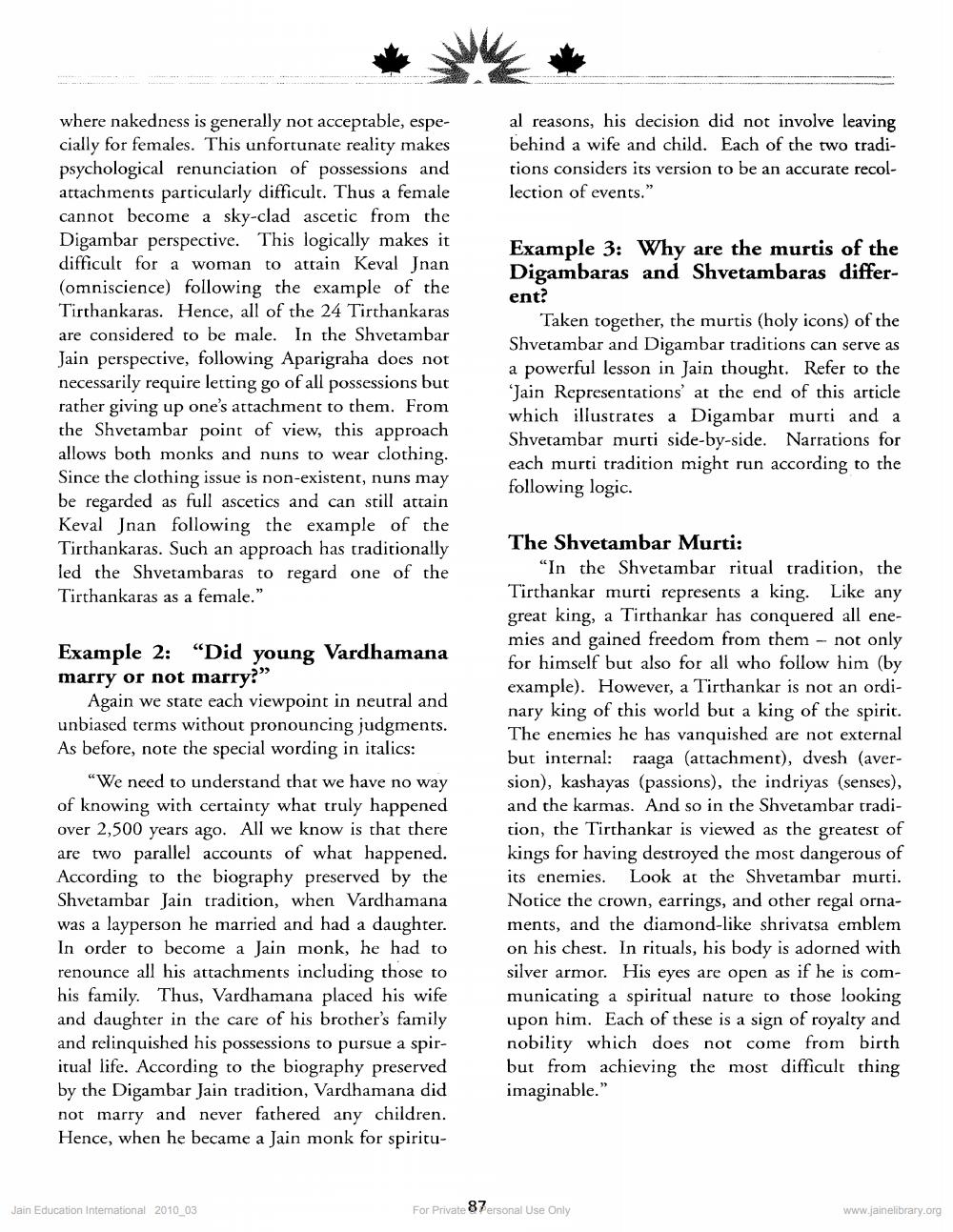________________
***
al reasons, his decision did not involve leaving behind a wife and child. Each of the two traditions considers its version to be an accurate recollection of events."
where nakedness is generally not acceptable, especially for females. This unfortunate reality makes psychological renunciation of possessions and attachments particularly difficult. Thus a female cannot become a sky-clad ascetic from the Digambar perspective. This logically makes it difficult for a woman to attain Keval Jnan (omniscience) following the example of the Tirthankaras. Hence, all of the 24 Tirthankaras are considered to be male. In the Shvetambar Jain perspective, following Aparigraha does not necessarily require letting go of all possessions but rather giving up one's attachment to them. From the Shvetambar point of view, this approach allows both monks and nuns to wear clothing. Since the clothing issue is non-existent, nuns may be regarded as full ascetics and can still attain Keval Jnan following the example of the Tirthankaras. Such an approach has traditionally led the Shvetambaras to regard one of the Tirthankaras as a female."
Example 3: Why are the murtis of the Digambaras and Shvetambaras different?
Taken together, the murtis (holy icons of the Shvetambar and Digambar traditions can serve as a powerful lesson in Jain thought. Refer to the “Jain Representations at the end of this article which illustrates a Digambar murti and a Shvetambar murti side-by-side. Narrations for each murti tradition might run according to the following logic.
Example 2: "Did young Vardhamana marry or not marry?”
Again we state each viewpoint in neutral and unbiased terms without pronouncing judgments. As before, note the special wording in italics:
"We need to understand that we have no way of knowing with certainty what truly happened over 2,500 years ago. All we know is that there are two parallel accounts of what happened. According to the biography preserved by the Shvetambar Jain tradition, when Vardhamana was a layperson he married and had a daughter. In order to become a Jain monk, he had to renounce all his attachments including those to his family. Thus, Vardhamana placed his wife and daughter in the care of his brother's family and relinquished his possessions to pursue a spiritual life. According to the biography preserved by the Digambar Jain tradition, Vardhamana did not marry and never fathered any children. Hence, when he became a Jain monk for spiritu
The Shvetambar Murti:
"In the Shvetambar ritual tradition, the Tirthankar murti represents a king. Like any great king, a Tirthankar has conquered all enemies and gained freedom from them - not only for himself but also for all who follow him (by example). However, a Tirthankar is not an ordinary king of this world but a king of the spirit. The enemies he has vanquished are not external but internal: raaga (attachment), dvesh (aversion), kashayas (passions), the indriyas (senses), and the karmas. And so in the Shvetambar tradition, the Tirthankar is viewed as the greatest of kings for having destroyed the most dangerous of its enemies. Look at the Shvetambar murti. Notice the crown, earrings, and other regal ornaments, and the diamond-like shrivatsa emblem on his chest. In rituals, his body is adorned with silver armor. His eyes are open as if he is communicating a spiritual nature to those looking upon him. Each of these is a sign of royalty and nobility which does not come from birth but from achieving the most difficult thing imaginable."
Jain Education Interational 2010_03
For Private 87ersonal Use Only
www.jainelibrary.org




